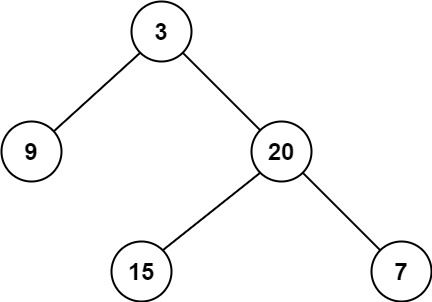给定一个二叉树,找出其最小深度。
最小深度是从根节点到最近叶子节点的最短路径上的节点数量。
说明:叶子节点是指没有子节点的节点。
示例 1:
输入:root = [3,9,20,null,null,15,7] 输出:2
示例 2:
输入:root = [2,null,3,null,4,null,5,null,6] 输出:5
提示:
- 树中节点数的范围在
[0, 105]内 -1000 <= Node.val <= 1000
若左子树和右子树其中一个为空,那么需要返回比较大的那个子树的深度加 1;左右子树都不为空,返回最小深度加 1 即可。
# Definition for a binary tree node.
# class TreeNode:
# def __init__(self, val=0, left=None, right=None):
# self.val = val
# self.left = left
# self.right = right
class Solution:
def minDepth(self, root: TreeNode) -> int:
def dfs(root):
if root is None:
return 0
if root.left is None:
return 1 + dfs(root.right)
if root.right is None:
return 1 + dfs(root.left)
return 1 + min(dfs(root.left), dfs(root.right))
return dfs(root)/**
* Definition for a binary tree node.
* public class TreeNode {
* int val;
* TreeNode left;
* TreeNode right;
* TreeNode() {}
* TreeNode(int val) { this.val = val; }
* TreeNode(int val, TreeNode left, TreeNode right) {
* this.val = val;
* this.left = left;
* this.right = right;
* }
* }
*/
class Solution {
public int minDepth(TreeNode root) {
return dfs(root);
}
private int dfs(TreeNode root) {
if (root == null) {
return 0;
}
if (root.left == null) {
return 1 + dfs(root.right);
}
if (root.right == null) {
return 1 + dfs(root.left);
}
return 1 + Math.min(dfs(root.left), dfs(root.right));
}
}/**
* Definition for a binary tree node.
* function TreeNode(val, left, right) {
* this.val = (val===undefined ? 0 : val)
* this.left = (left===undefined ? null : left)
* this.right = (right===undefined ? null : right)
* }
*/
/**
* @param {TreeNode} root
* @return {number}
*/
var minDepth = function (root) {
function dfs(root) {
if (!root) return 0;
if (!root.left) return 1 + dfs(root.right);
if (!root.right) return 1 + dfs(root.left);
return 1 + Math.min(dfs(root.left), dfs(root.right));
}
return dfs(root);
};/**
* Definition for a binary tree node.
* struct TreeNode {
* int val;
* TreeNode *left;
* TreeNode *right;
* TreeNode() : val(0), left(nullptr), right(nullptr) {}
* TreeNode(int x) : val(x), left(nullptr), right(nullptr) {}
* TreeNode(int x, TreeNode *left, TreeNode *right) : val(x), left(left), right(right) {}
* };
*/
class Solution {
public:
int minDepth(TreeNode* root) {
return dfs(root);
}
int dfs(TreeNode* root) {
if (!root) return 0;
if (!root->left) return 1 + dfs(root->right);
if (!root->right) return 1 + dfs(root->left);
return 1 + min(dfs(root->left), dfs(root->right));
}
};/**
* Definition for a binary tree node.
* type TreeNode struct {
* Val int
* Left *TreeNode
* Right *TreeNode
* }
*/
func minDepth(root *TreeNode) int {
var dfs func(root *TreeNode) int
dfs = func(root *TreeNode) int {
if root == nil {
return 0
}
if root.Left == nil {
return 1 + dfs(root.Right)
}
if root.Right == nil {
return 1 + dfs(root.Left)
}
return 1 + min(dfs(root.Left), dfs(root.Right))
}
return dfs(root)
}
func min(a, b int) int {
if a < b {
return a
}
return b
}
